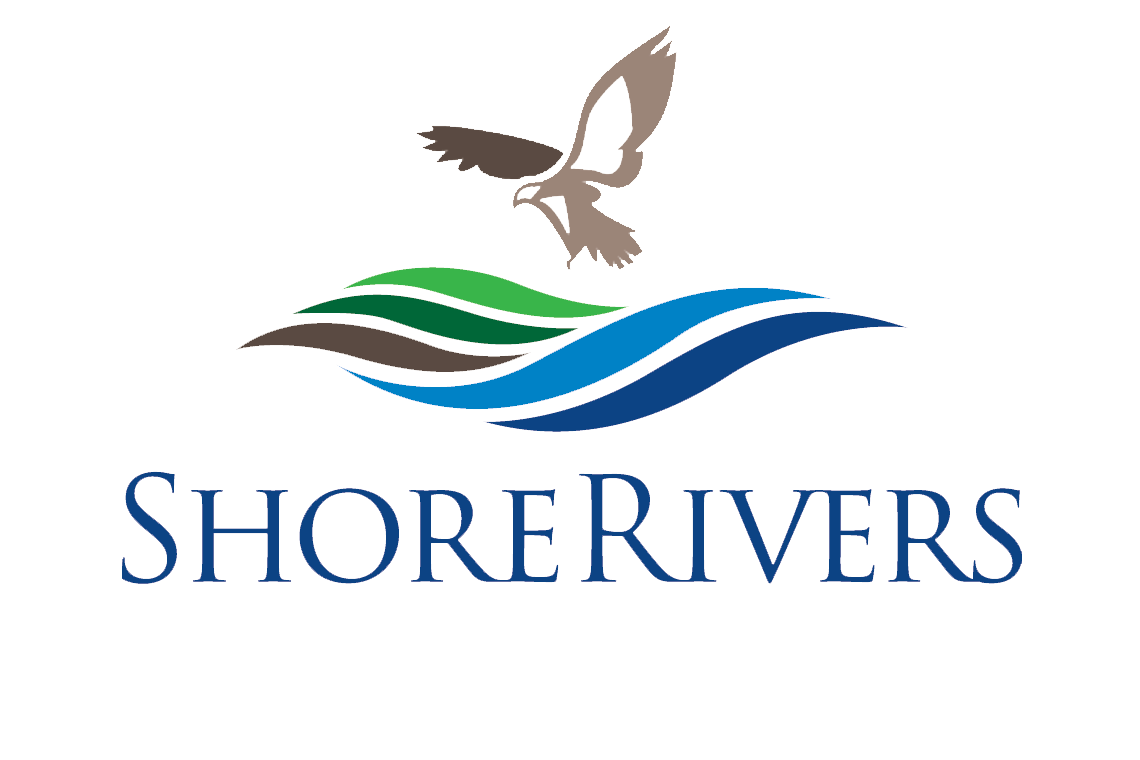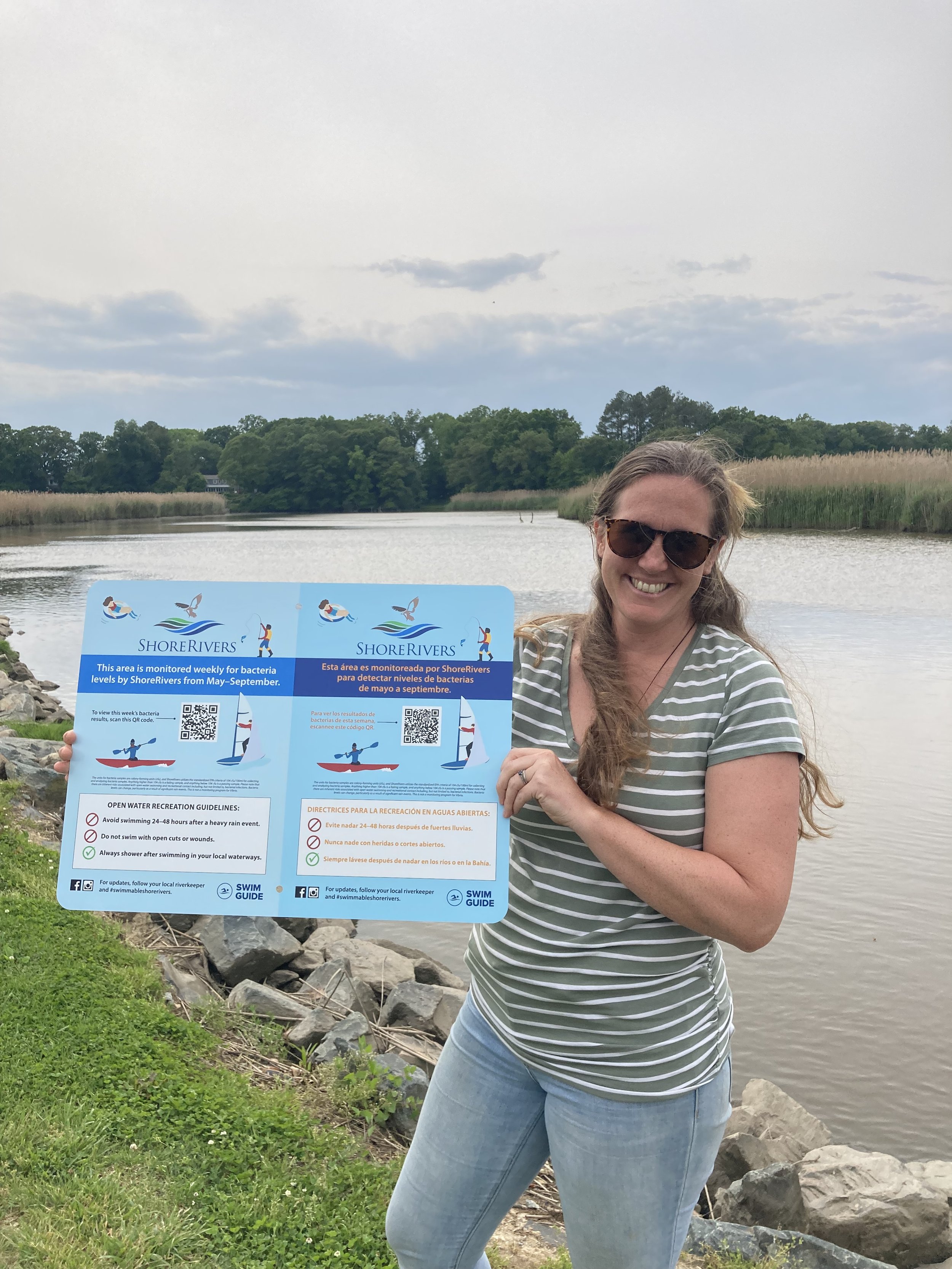Chester Riverkeeper Annie Richards shows off one of ShoreRivers’ new informational signs at Morgnec Landing on Morgan Creek. Located at 14 sites (and counting) across the Eastern Shore, these signs provide information on bacteria in our waterways and the Swimmable ShoreRivers program, in addition to and showing users where to find weekly test results in both English and Spanish.
ShoreRivers is pleased to announce that not only will its Swimmable ShoreRivers bacteria testing program begin Thursday, May 25, but that weekly results from this annual program will be available this year in both English and Spanish.
Every summer, ShoreRivers deploys a team of community scientists to monitor bacteria levels at popular swimming and boating sites to provide important human health risk information to the public. Their samples are then processed, according to standard scientific protocols, in ShoreRivers in-house labs. The program follows the Environmental Protection Agency’s standard protocols for collecting and analyzing samples and makes public the results of that testing to let people know about current bacteria levels as they make their plans for recreating in our waterways. Results are posted every Friday, between Memorial Day and Labor Day, at shorerivers.org/swim and on both the organization’s and its individual Riverkeepers’ social media pages.
Choptank Riverkeeper Matt Pluta holds water quality samples. This summer, ShoreRivers and a team of volunteer SwimTesters will monitor bacteria levels at sites around the region, providing a critical public health service for communities and identifying pollution hotspots for future restoration efforts.
A second page, shorerivers.org/swimmable-shorerivers-espanol, has been set up to share this program with the Spanish-speaking community, and 14 signs can be found at public sites around the Eastern Shore that explain the goals of the Swimmable ShoreRivers program and show users where to find weekly results in both English and Spanish. These signs were made possible thanks to funding from the Cornell Douglas Foundation, and ShoreRivers’ Riverkeepers will continue working throughout the season with local county officials to install more. Want to see one at your favorite local landing? Reach out to your Riverkeeper about adding a site, and talk to your county officials about installing one of these free and informative signs.
Weekly results are also shared on theswimguide.org, where descriptions of testing sites have also been added in both languages.
“At ShoreRivers, we believe that access to clean water is an essential right for all of our communities,” said Chester Riverkeeper Annie Richards. “It was important to us to be able to offer informational access to more of our community, and we hope to continue expanding this access in the future.”
This public service provided by ShoreRivers truly is a community effort: this summer, 61 SwimTesters will monitor 46 sites on the Choptank, Miles, Wye, Chester, and Sassafras rivers; Eastern Bay; and the Bayside Creeks. Special thanks go to our generous site sponsors, who include towns, marinas, homeowner’s associations, and families.
Bacteria levels in our rivers and tributaries vary based on location, land use, and weather—making systematic, scientific analysis of local water quality vital. Major rain events are almost always connected to spikes in bacteria levels, and outgoing tides have a higher probability of carrying bacteria pollution. Potential chronic sources of bacteria include failing septic systems, overflows or leaks from wastewater treatment plants, waste from animal farms, or manure fertilizer.
Also returning for the 2023 season is ShoreRivers’ Pumpout Boat, which begins running during Memorial Day weekend. The Pumpout Boat is a free service offered on the Miles and Wye rivers, that docks at the Chesapeake Bay Maritime Museum in St. Michaels and operates from May to mid-October. With your help, this boat will help prevent more than 20,000 gallons of concentrated marine waste from entering our waters annually. To schedule a pump-out, contact Captain Jim Freeman at 410-829-4352, on VHF Channel 9, email POBCaptJim@gmail.com, or by using the form at shorerivers.org/programs/pumpout-boat.




